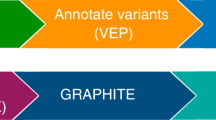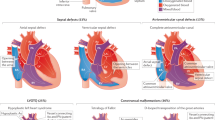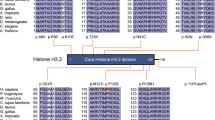Abstract
Congenital heart disease (CHD) is the most frequent birth defect, affecting 0.8% of live births1. Many cases occur sporadically and impair reproductive fitness, suggesting a role for de novo mutations. Here we compare the incidence of de novo mutations in 362 severe CHD cases and 264 controls by analysing exome sequencing of parent–offspring trios. CHD cases show a significant excess of protein-altering de novo mutations in genes expressed in the developing heart, with an odds ratio of 7.5 for damaging (premature termination, frameshift, splice site) mutations. Similar odds ratios are seen across the main classes of severe CHD. We find a marked excess of de novo mutations in genes involved in the production, removal or reading of histone 3 lysine 4 (H3K4) methylation, or ubiquitination of H2BK120, which is required for H3K4 methylation2,3,4. There are also two de novo mutations in SMAD2, which regulates H3K27 methylation in the embryonic left–right organizer5. The combination of both activating (H3K4 methylation) and inactivating (H3K27 methylation) chromatin marks characterizes ‘poised’ promoters and enhancers, which regulate expression of key developmental genes6. These findings implicate de novo point mutations in several hundreds of genes that collectively contribute to approximately 10% of severe CHD.
This is a preview of subscription content, access via your institution
Access options
Subscribe to this journal
Receive 51 print issues and online access
$199.00 per year
only $3.90 per issue
Buy this article
- Purchase on Springer Link
- Instant access to full article PDF
Prices may be subject to local taxes which are calculated during checkout


Similar content being viewed by others
Accession codes
Data deposits
Messenger RNA and protein sequences are available in the RefSeq database (http://www.ncbi.nlm.nih.gov/refseq/) under accession numbers listed in Supplementary Table 4; mutation data are available at dbSNP (http://www.ncbi.nlm.nih.gov/snp) under batch accession 1059065.
References
Reller, M. D., Strickland, M. J., Riehle-Colarusso, T., Mahle, W. T. & Correa, A. Prevalence of congenital heart defects in metropolitan Atlanta, 1998–2005. J. Pediatr. 153, 807–813 (2008)
Shilatifard, A. The COMPASS family of histone H3K4 methylases: mechanisms of regulation in development and disease pathogenesis. Annu. Rev. Biochem. 81, 65–95 (2012)
Pedersen, M. T. & Helin, K. Histone demethylases in development and disease. Trends Cell Biol. 20, 662–671 (2010)
Fuchs, G. et al. RNF20 and USP44 regulate stem cell differentiation by modulating H2B monoubiquitylation. Mol. Cell 46, 662–673 (2012)
Dahle, Ø., Kumar, A. & Kuehn, M. R. Nodal signaling recruits the histone demethylase Jmjd3 to counteract polycomb-mediated repression at target genes. Sci. Signal. 3, ra48 (2010)
Bernstein, B. E. et al. A bivalent chromatin structure marks key developmental genes in embryonic stem cells. Cell 125, 315–326 (2006)
Pediatric Cardiac Genomics Consortium. The Congenital Heart Disease Network Study (CHD GENES): rationale, design and early results. Circ. Res. 112, 698–706 (2013)
Boyden, L. M. et al. Mutations in kelch-like 3 and cullin 3 cause hypertension and electrolyte abnormalities. Nature 482, 98–102 (2012)
Sanders, S. J. et al. De novo mutations revealed by whole-exome sequencing are strongly associated with autism. Nature 485, 237–241 (2012)
Scally, A. & Durbin, R. Revising the human mutation rate: implications for understanding human evolution. Nature Rev. Genet. 13, 745–753 (2012)
Lederer, D. et al. Deletion of KDM6A, a histone demethylase interacting with MLL2, in three patients with Kabuki syndrome. Am. J. Hum. Genet. 90, 119–124 (2012)
Vissers, L. E. et al. Mutations in a new member of the chromodomain gene family cause CHARGE syndrome. Nature Genet. 36, 955–957 (2004)
Gendron, R. L., Adams, L. C. & Paradis, H. Tubedown-1, a novel acetyltransferase associated with blood vessel development. Dev. Dyn. 218, 300–315 (2000)
Greenway, S. C. et al. De novo copy number variants identify new genes and loci in isolated sporadic tetralogy of Fallot. Nature Genet. 41, 931–935 (2009)
Wamstad, J. A. et al. Dynamic and coordinated epigenetic regulation of developmental transitions in the cardiac lineage. Cell 151, 206–220 (2012)
Paige, S. L. et al. A temporal chromatin signature in human embryonic stem cells identifies regulators of cardiac development. Cell 151, 221–232 (2012)
Ceol, C. J. et al. The histone methyltransferase SETDB1 is recurrently amplified in melanoma and accelerates its onset. Nature 471, 513–517 (2011)
Sausen, M. et al. Integrated genomic analyses identify ARID1A and ARID1B alterations in the childhood cancer neuroblastoma. Nature Genet. 45, 12–17 (2013)
O'Roak, B. J. et al. Sporadic autism exomes reveal a highly interconnected protein network of de novo mutations. Nature 485, 246–250 (2012)
Iossifov, I. et al. De novo gene disruptions in children on the autistic spectrum. Neuron 74, 285–299 (2012)
Neale, B. M. et al. Patterns and rates of exonic de novo mutations in autism spectrum disorders. Nature 485, 242–245 (2012)
O’Roak, B. J. et al. Multiplex targeted sequencing identifies recurrently mutated genes in autism spectrum disorders. Science 338, 1619–1622 (2012)
Kong, A. et al. Rate of de novo mutations and the importance of father’s age to disease risk. Nature 488, 471–475 (2012)
Vorstman, J. A., Breetvelt, E. J., Thode, K. I., Chow, E. W. & Bassett, A. S. Expression of autism spectrum and schizophrenia in patients with a 22q11.2 deletion. Schizophr. Res. 143, 55–59 (2013)
Mefford, H. C. et al. Recurrent rearrangements of chromosome 1q21.1 and variable pediatric phenotypes. N. Engl. J. Med. 359, 1685–1699 (2008)
Ghebranious, N., Giampietro, P. F., Wesbrook, F. P. & Rezkalla, S. H. A novel microdeletion at 16p11.2 harbors candidate genes for aortic valve development, seizure disorder, and mild mental retardation. Am. J. Med. Genet. 143A, 1462–1471 (2007)
Soemedi, R. et al. Contribution of global rare copy-number variants to the risk of sporadic congenital heart disease. Am. J. Hum. Genet. 91, 489–501 (2012)
Fischbach, G. D. & Lord, C. The Simons Simplex Collection: a resource for identification of autism genetic risk factors. Neuron 68, 192–195 (2010)
Christodoulou, D. C., Gorham, J. M., Herman, D. S. & Seidman, J. G. Construction of normalized RNA-seq libraries for next-generation sequencing using the crab duplex-specific nuclease. Curr. Protoc. Mol. Biol. 94:4.12.1–4.12.11. (2011)
Herman, D. S. et al. Truncations of titin causing dilated cardiomyopathy. N. Engl. J. Med. 366, 619–628 (2012)
Acknowledgements
The authors are grateful to the patients and families who participated in this research. We thank the following team members for contributions to patient recruitment: D. Awad, K. Celia, D. Etwaru, R. Korsin, A. Lanz, E. Marquez, J. K. Sond, A. Wilpers, R. Yee (Columbia Medical School); K. Boardman, J. Geva, J. Gorham, B. McDonough, A. Monafo, J. Stryker (Harvard Medical School); N. Cross (Yale School of Medicine); S. M. Edman, J. L. Garbarini, J. E. Tusi, S. H. Woyciechowski (Children’s Hospital of Philadelphia); J. Ellashek and N. Tran (Children’s Hospital of Los Angeles); K. Flack (University College London); D.Gruber, N. Stellato (Steve and Alexandra Cohen Children’s Medical Center of New York); D. Guevara, A. Julian, M. Mac Neal, C. Mintz (Icahn School of Medicine at Mount Sinai); and E. Taillie (University of Rochester School of Medicine and Dentistry). We also thank V. Spotlow, P. Candrea, K. Pavlik and M. Sotiropoulos for their expert production of exome sequences. We thank B. Bernstein and R. Ryan (Massachusetts General Hospital) and B. Bruneau (Gladstone Institute and University of California, San Francisco) for discussions. This work was supported by the National Institutes of Health (NIH) National Heart, Lung, and Blood Institute (NHLBI) Pediatric Cardiac Genomics Consortium (U01-HL098188, U01-HL098147, U01-HL098153, U01-HL098163, U01-HL098123, U01-HL098162) and in part by the Simons Foundation for Autism Research and the NIH Centers for Mendelian Genomics (5U54HG006504).
Author information
Authors and Affiliations
Contributions
Study design: M.B., W.K.C., B.D.G., E.G., H.H., J.R.K., R.P.L., L.E.M., J.G.S., C.E.S., D.W., P.S.W.; cohort ascertainment, phenotypic characterization and recruitment: R.E.B., M.B., W.K.C., J.D., B.D.G., E.G., J.K., R.K., T.L., J.W.N., G.P., A.R.-A., H.S.S., C.E.S., I.A.W.; informatics/data management: R.D.B., R.E.B., N.J.C., M.C., S.D., J.G., H.H., M.J.I., J.L., A.L., S.M.M., J.D.O., M.P., A.E.R., J.G.S., W.W., P.S.W., S.Z.; exome sequencing production: J.D.O., A.L., R.P.L., S.M.M., M.W.S., I.R.T.; de novo mutation validation: W.K.C., L.M.; exome sequencing analysis: K.K.B., Y.H.C., M.C., S.D., K.A.F., J.G., J.K.K., R.P.L., I.P., R.S., S.J.S., J.G.S., C.E.S., S.S., W.W., S.Z.; RNA sequence production/analysis: J.J., M.P., C.E.S., J.G.S., H.W.; statistical analysis: M.C., R.P.L., I.P., A.E.R., C.E.S., J.G.S., S.Z., H.Z.; writing of manuscript: M.B., M.C., W.K.C., B.D.G., E.G., J.R.K., R.P.L., C.E.S., S.Z. Co-senior authors: M.B., W.K.C., B.D.G., E.G., C.E.S. and R.P.L.
Corresponding authors
Ethics declarations
Competing interests
The authors declare no competing financial interests.
Supplementary information
Supplementary Information
This file contains Supplementary Text and Data, Supplementary Tables 1-13 and Supplementary Figures 1-9. (PDF 2282 kb)
PowerPoint slides
Rights and permissions
About this article
Cite this article
Zaidi, S., Choi, M., Wakimoto, H. et al. De novo mutations in histone-modifying genes in congenital heart disease. Nature 498, 220–223 (2013). https://doi.org/10.1038/nature12141
Received:
Accepted:
Published:
Issue Date:
DOI: https://doi.org/10.1038/nature12141
This article is cited by
-
Contribution of genetic variants to congenital heart defects in both singleton and twin fetuses: a Chinese cohort study
Molecular Cytogenetics (2024)
-
Statistical methods for assessing the effects of de novo variants on birth defects
Human Genomics (2024)
-
LZTR1 deficiency exerts high metastatic potential by enhancing sensitivity to EMT induction and controlling KLHL12-mediated collagen secretion
Cell Death & Disease (2023)
-
Inhibition of fatty acid oxidation enables heart regeneration in adult mice
Nature (2023)
-
Adult Congenital Heart Disease in the Aging and Elderly Population
Current Geriatrics Reports (2023)
Comments
By submitting a comment you agree to abide by our Terms and Community Guidelines. If you find something abusive or that does not comply with our terms or guidelines please flag it as inappropriate.



